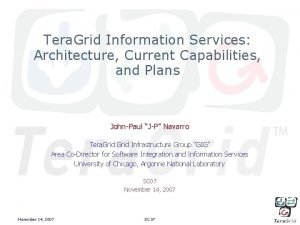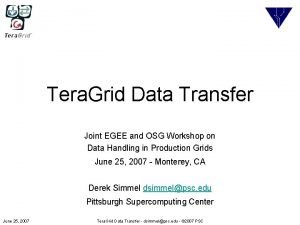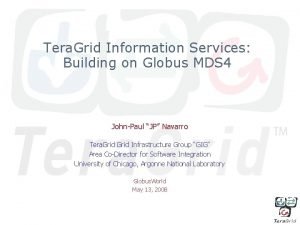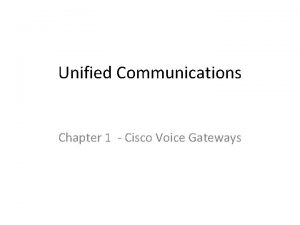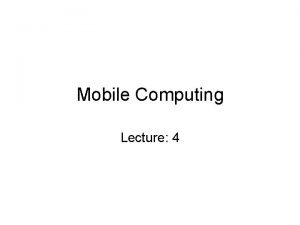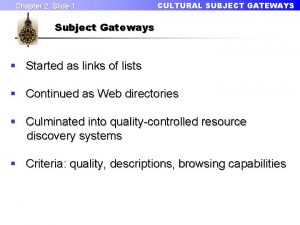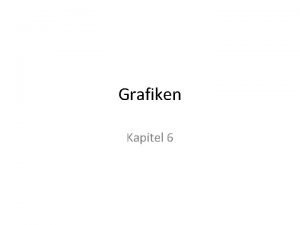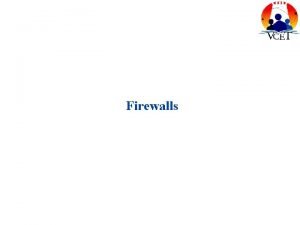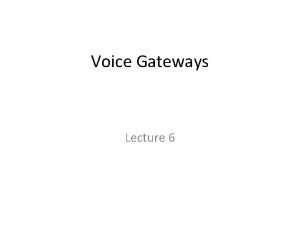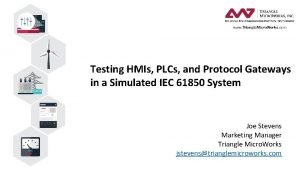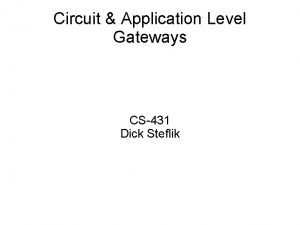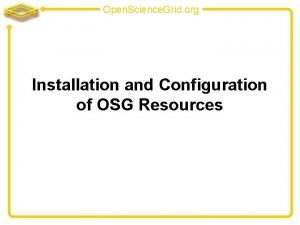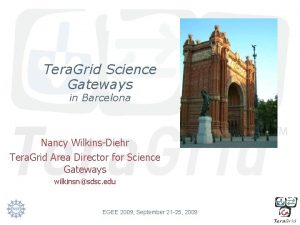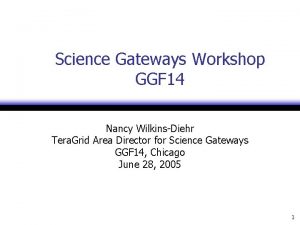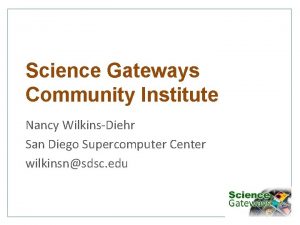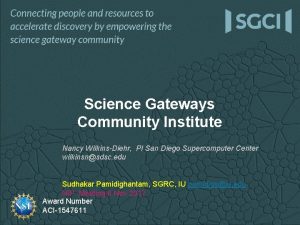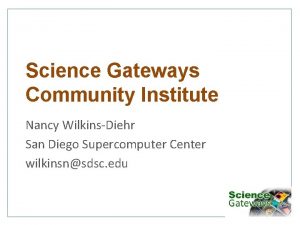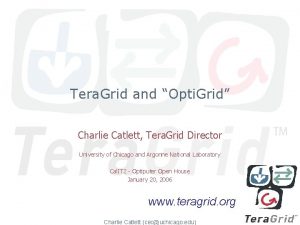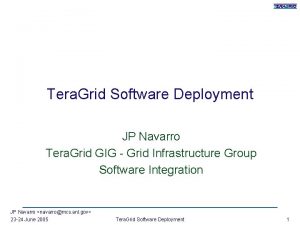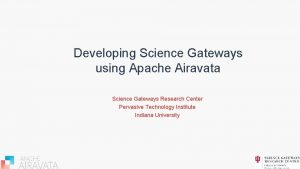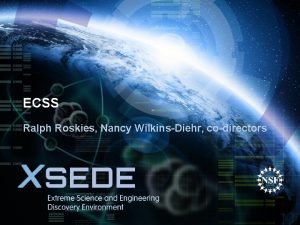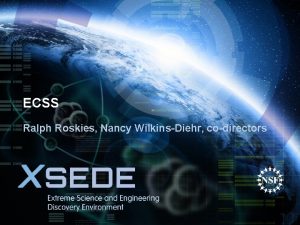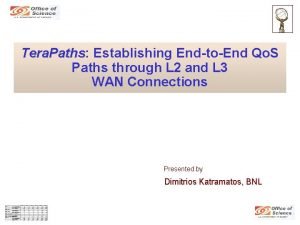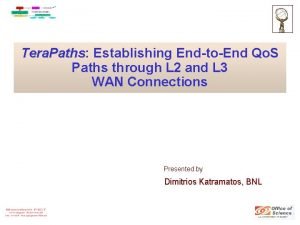Science Gateways on the Tera Grid Nancy WilkinsDiehr
















- Slides: 16

Science Gateways on the Tera. Grid Nancy Wilkins-Diehr Area Director for Science Gateways San Diego Supercomputer Center wilkinsn@sdsc. edu

Today’s Outline • What are Gateways? • Why Tera. Grid and Gateways? • Initial Strategy • Implementation Details – Issues to address when using TG • Future growth

Gateways are part of TG’s 3 -pronged strategy to further science • DEEP Science: Enabling Terascale Science – Make science more productive through an integrated set of veryhigh capability resources • ASTA projects • WIDE Impact: Empowering Communities – Bring Tera. Grid capabilities to the broad science community • Science Gateways • OPEN Infrastructure, OPEN Partnership – Provide a coordinated, general purpose, reliable set of services and resources • Grid interoperability working group

Science Gateways A new initiative for the Tera. Grid • Increasing investment by communities in their own cyberinfrastructure, but heterogeneous: • Resources • Users – from expert to K-12 • Software stacks, policies • Science Gateways – Provide “Tera. Grid Inside” capabilities – Leverage community investment • Three common forms: – Web-based Portals – Application programs running on users' machines but accessing services in Tera. Grid – Coordinated access points enabling users to move seamlessly between Tera. Grid and other grids. Workflow Composer

Initial Focus on 10 Gateways

National Virtual Observatory Facilitating Scientific Discovery • Astronomy is increasingly a data-rich science • New science enabled by enhancing access to data and computing resources • Ease of use in locating, retrieving, and analyzing data from archives and catalogs worldwide • NVO is a set of tools used to exploit the data avalanche

Nano. HUB Middleware infrastructure Science Gateway Workspaces Campus Grids Capability Computing Purdue, GLOW Middleware Grid VM nano. HUB VO Virtual backends Capacity Computing Research apps Virtual Cluster with VIOLIN

spruce. teragrid. org Special Priority and Urgent Computing Environment

Linked Environments for Atmospheric Discovery LEAD • Providing tools that are needed to make accurate predictions of tornados and hurricanes • Data exploration and Grid workflow

Gateways are growing in numbers • • • 10 initial projects as part of TG proposal >20 Gateway projects today No limit on how many gateways can use TG resources – Prepare services and documentation so developers can work independently • • • • Open Science Grid (OSG) Special PRiority and Urgent Computing Environment (SPRUCE) National Virtual Observatory (NVO) Linked Environments for Atmospheric Discovery (LEAD) Computational Chemistry Grid (Grid. Chem) Computational Science and Engineering Online (CSEOnline) GEON(GEOsciences Network) Network for Earthquake Engineering Simulation (NEES) SCEC Earthworks Project Network for Computational Nanotechnology and nano. HUB GIScience Gateway (GISolve) Biology and Biomedicine Science Gateway Open Life Sciences Gateway The Telescience Project Grid Analysis Environment (GAE) Neutron Science Instrument Gateway Tera. Grid Visualization Gateway, ANL BIRN Gridblast Bioinformatics Gateway Earth Systems Grid Cornell • Many others interested • • – – SID Grid HASTAC

NCAR Earth System Grid • ESG originally a distributed data management/access system but it has evolved into more. • User registration, authorization controls, and metrics tracking • CCSM model source, initialization datasets, post-processing codes, and analysis and visualization tools. • Prototypes of model- submission environments, eventually realtime tracking of model status along with references to available output datasets. • "science gateway" for climate research. • Expect to see more model runs at higher- resolution and with greater component scope.

So how will we meet all these needs? • With RATS! (Requirements Analysis Teams) • Collection, analysis and consolidation of requirements to jump start the work – Interviews with 10 Gateways – Common user models, accounting needs, scheduling needs • Summarized requirements for each Tera. Grid working group – Accounting, Security, Web Services, Software • Areas for more study identified • Primer outline for new Gateways in progress • And milestones

Implications for Tera. Grid working groups • Accounting – Support for accounts with differing capabilities – Ability to associate compute job to a individual portal user – Scheme for portal registration and usage tracking – Support for OSG’s Grid User Management System (GUMS) – Dynamic accounts • Security – Community account privileges – Need to identify human responsible for a job for incident response – Acceptance of other grid certificates – TG-hosted web servers, cgi-bin code • Web Services – Initial analysis completed 12/05 – Some Gateways (LEAD, Open Life Sciences) have immediate needs – Many will build on capabilities offered by GT 4, but interoperability could be an issue – Web Service security – Interfaces to scheduling and account management are common requirements • Software – Interoperability of software stacks between TG and peer grids – Software installations for gateways across all TG sites – Community software areas – Management (pacman, other options)

Gateway Web Services Needs • Interfaces provided by the Tera. Grid The list of services that have been identified by the gateways developers includes: – Resource Status Service (both polling and pub/sub) – Job Submission Interface • The gateways expect this to be provided by WS-GRAM – – – – Job Tracking Interface (Both polling and pub/sub) File/Data Staging Interface Retrieve Usage Information Retrieve Inca Info Advanced Reservation Interface Cross-site Run interface Pushing DN to an RP interface • Interfaces provided by the Gateways The list of services that have been identified by the gateways developers and the Tera. Grid Security group includes: – Retrieve user information for a job – Retrieve accounting information/statistics – Provides the necessary means to track down problem job submissions, identify malicious users, and tabulate accounting and logging information for reporting needs by the RPs. It is expected that the information provided for the first interface is simply the (resource, job id) that is known by both parties at job submission time. This interface provides sufficient user information for the RPs to deal with the situation at hand, and possibly identifies another interface that should be provided by the gateways: – Don't submit jobs from the user who submitted job (resource, job id), until we say it's Ok. – The accounting interface requires no information, but returns sufficient accounting information and statistics to report to funding agencies, program managers, etc.

Gateway primer and “getting started” documentation by end of summer 1. Introduction 2. Science Gateway in Context a. Science Gateway (SGW) Definition(s) b. Science Gateway user modes c. Distinction between SGW and other Tera. Grid user modes 3. Components of a Science Gateway a. User Model b. Gateway targeted community c. Gateway Services d. Integration with Tera. Grid external resources (data collections, services, …) e. Organizational and administrative structure 4. Tera. Grid services and policies available for Science Gateways a. Portal middleware tools (user portal and other portal tools) b. Account Management (user models, community accounts, ) c. Security environment (security models) d. Web Services e. Scheduling services (and meta-scheduling) f. Community accounts and allocations g. Community Software Areas h. All traditional Tera. Grid services and resources i. Ability to propose additional services and how that would interact with Tera. Grid operations 5. Responsibilities and Requirements for Science Gateways a. Interaction with and compatibility with Tera. Grid communities b. Control procedures i. Community user identification and tracking (map Tera. Grid usage to Portal user) ii. Use monitoring and reporting iii. Security and trust iv. Appropriate use 6. How to get started a. Existing resources i. Publication references ii. Web areas with more details iii. Online tutorials iv. Upcoming presentations and tutorials b. Who to contact for initial discussions c. How to propose a new Gateway d. How to integrate with Tera. Grid Gateways efforts. e. How to obtain a resource allocation

Want to be involved? • gateways@teragrid. org mailing list – – • Email majordomo@teragrid. org <subscribe gateways> in body Biweekly telecons to get advice from others. Current focus – – – Auditing strategy Mini-tutorial at April Lariat workshop, “Accelerating Research Through Grid Computing” Hands on tutorial at June conference • • – – • Overview of Gateways In depth presentations by LEAD, nano. HUB, RENCI, GIScience Transition to GT 4 Scheduling requirements • As original gateways move into production, we will be able to provide short term support to new projects that would benefit from utilizing Tera. Grid resources www. teragrid. org • Nancy Wilkins-Diehr, wilkinsn@sdsc. edu
 Tera grid
Tera grid Tera joint
Tera joint Tera grid
Tera grid Lga pga
Lga pga Cisco pstn gateway
Cisco pstn gateway Behaviour management middleware
Behaviour management middleware Reverie allan houser
Reverie allan houser Pfa compliance checklist
Pfa compliance checklist Subject gateways example
Subject gateways example Bpmn gateways
Bpmn gateways Circuit level gateway firewall
Circuit level gateway firewall Tdm pstn
Tdm pstn Protocol gateways
Protocol gateways Protocol gateways
Protocol gateways Application level gateways
Application level gateways Her favourite subject be english
Her favourite subject be english Open science grid
Open science grid
